| Pages:
1
2 |
ampakine
Harmless

Posts: 25
Registered: 29-4-2011
Member Is Offline
Mood: No Mood
|
|
Boil off the water then try recrystallising from water or another suitable solvent.
|
|
|
IndependentBoffin
Hazard to Others
  
Posts: 150
Registered: 15-4-2011
Member Is Offline
Mood: No Mood
|
|
Alright guys here's what I did today:
I got 1 mole of impure (NH<sub>4</sub> <sub>2</sub>SO<sub>4</sub> as Sinclair Sulphate of Ammonia fertiliser of mas 132.1g. As you can see from the picture it is
extremely dirty when it should be white crystals. <sub>2</sub>SO<sub>4</sub> as Sinclair Sulphate of Ammonia fertiliser of mas 132.1g. As you can see from the picture it is
extremely dirty when it should be white crystals.
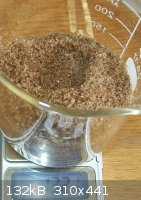
I then added roughly 200ml of water so that the crystals should dissolve completely. 200ml should dissolve 148.8g at 20C.
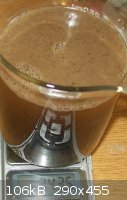
The dissolved stuff is shown below. Note the insoluble sediment stuck to the walls of the flask and near opaque brown colour.
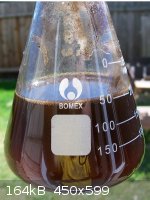
The filtered stuff is shown next:
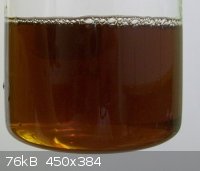
And what gunk we find in the filter paper! Clarification: no activated carbon was used yet and the black stuff in the filter paper was what was in the
fertiliser, and not added by me.
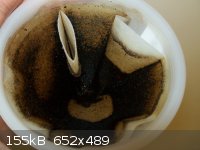
I will boil off as much water as possible and then try to recrystallise. 25kg of dirty sulphate of ammonia fertiliser cost about £50 incl. shipping.
Not worth the trouble, in terms of time, hassle and electricity.
Does anyone know a supplier who will sell a 25kg sack of purer (NH<sub>4</sub> <sub>2</sub>SO<sub>4</sub> fertiliser in the UK? <sub>2</sub>SO<sub>4</sub> fertiliser in the UK?
BTW the boiling point of the (NH<sub>4</sub> <sub>2</sub>SO<sub>4</sub> solution is about 106 Celcius. I'm not going to risk leaving the electric hotplate on overnight
even on low to dry the sample so I'll call it a day and continue tomorrow. <sub>2</sub>SO<sub>4</sub> solution is about 106 Celcius. I'm not going to risk leaving the electric hotplate on overnight
even on low to dry the sample so I'll call it a day and continue tomorrow.
[Edited on 1-5-2011 by IndependentBoffin]
I can sell the following:
1) Various high purity non-ferrous metals - Ni, Co, Ta, Zr, Mo, Ti, Nb.
2) Alkex para-aramid Korean Kevlar analogue fabric (about 50% Du Pont's prices)
3) NdFeB magnets
4) High purity technical ceramics
|
|
|
ldanielrosa
Hazard to Others
  
Posts: 124
Registered: 25-4-2007
Member Is Offline
Mood: transparent
|
|
You can dissolve more ammonium sulfate in boiling water, then let it cool to room temperature and some crystals will precipitate out. Remove crystals,
reheat and repeat until the crystals come out dirty.
As for overnight, a crock pot filled with sand is a wonderful thing.
|
|
|
IndependentBoffin
Hazard to Others
  
Posts: 150
Registered: 15-4-2011
Member Is Offline
Mood: No Mood
|
|
Well folks after boiling down the solution to about half volume late at night and letting it cool down + recrystallise overnight, I filtered out the
remaining aqueous solution and scooped out the crystals.
With heating, more brown insoluble sediment has appeared in the solution, which started off clear brown. The insoluble sediment is caught in the
filter paper as seen below.
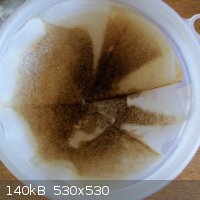
The filtered solution is a lighter brown than in previous pictures.
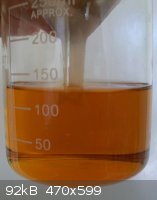
But the recrystallised ammonium sulphate crystals are still filthy:
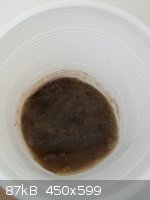
So it seems that the impurity in the (NH<sub>4</sub> <sub>2</sub>SO<sub>4</sub> is something which decomposes or undergoes a chemical change at about 106 Celcius (the BP of the
saturated (NH<sub>4</sub> <sub>2</sub>SO<sub>4</sub> is something which decomposes or undergoes a chemical change at about 106 Celcius (the BP of the
saturated (NH<sub>4</sub> <sub>2</sub>SO<sub>4</sub> solution) to produce impurities with a dark brown colour and insoluble brown-black precipitates. <sub>2</sub>SO<sub>4</sub> solution) to produce impurities with a dark brown colour and insoluble brown-black precipitates.
I can sell the following:
1) Various high purity non-ferrous metals - Ni, Co, Ta, Zr, Mo, Ti, Nb.
2) Alkex para-aramid Korean Kevlar analogue fabric (about 50% Du Pont's prices)
3) NdFeB magnets
4) High purity technical ceramics
|
|
|
a_bab
Hazard to Others
  
Posts: 458
Registered: 15-9-2002
Member Is Offline
Mood: Angry !!!!!111111...2?!
|
|
I'd dare to say your ammonium sulphate is adulterated with some sulphate, that would somehow react and turn to the insoluble, disgusting-looking iron
hydroxide when boiled.
|
|
|
IndependentBoffin
Hazard to Others
  
Posts: 150
Registered: 15-4-2011
Member Is Offline
Mood: No Mood
|
|
I don't have the chemicals to do a thiocyanate test (which might be too sensitive anyway) and carbonate test (would sodium bicarbonate do?) but AIUI
Fe<sup>3+</sup> catalyses the decomposition of H<sub>2</sub>O<sub>2</sub>.
I added some 35% H<sub>2</sub>O<sub>2</sub> to the brown recrystallised (NH<sub>4</sub> <sub>2</sub>SO<sub>4</sub> and got no effervescence. I'm
waiting to see if any bleaching of the brown colour occurs. <sub>2</sub>SO<sub>4</sub> and got no effervescence. I'm
waiting to see if any bleaching of the brown colour occurs.
Good suggestion though, Fe<sup>3+</sup> is brown and soluble with the right anion.
There can't be many brown soluble salts that go even more brown and produce a brown/black precipitate when heated at 106 Celcius. Has to be organic to
have such a low decomposition temperature, but if so why can't activated carbon get rid of it? The organic molecule has to be simple or with lots of
polar groups to be so soluble in water.
[Edited on 2-5-2011 by IndependentBoffin]
I can sell the following:
1) Various high purity non-ferrous metals - Ni, Co, Ta, Zr, Mo, Ti, Nb.
2) Alkex para-aramid Korean Kevlar analogue fabric (about 50% Du Pont's prices)
3) NdFeB magnets
4) High purity technical ceramics
|
|
|
pjig
Hazard to Others
  
Posts: 169
Registered: 25-5-2010
Member Is Offline
Mood: always learning
|
|
Maybe it would be worth ditching that batch of A-sulfate and purchasing from a diff source. It is a cheap material, and not worth the time your
spending in trying to clean it up.
Id try to get the hydro-grade crystal A-sulfate. It has way less impurities and dissolves very well.
|
|
|
IndependentBoffin
Hazard to Others
  
Posts: 150
Registered: 15-4-2011
Member Is Offline
Mood: No Mood
|
|
Yeah I had already decided to do that. I just find it really annoying that I don't know what the impurity is and my methods to separate it out are
failing.
You know that feeling when you have a puzzle you can't solve in front of you? I'm just trying to purify it now for the science.
P.S. I have about 25 kg of impure ammonium sulphate fertiliser for sale. Any takers? 
I can sell the following:
1) Various high purity non-ferrous metals - Ni, Co, Ta, Zr, Mo, Ti, Nb.
2) Alkex para-aramid Korean Kevlar analogue fabric (about 50% Du Pont's prices)
3) NdFeB magnets
4) High purity technical ceramics
|
|
|
watson.fawkes
International Hazard
    
Posts: 2793
Registered: 16-8-2008
Member Is Offline
Mood: No Mood
|
|
Quote: Originally posted by IndependentBoffin  | So it seems that the impurity in the (NH<sub>4</sub> <sub>2</sub>SO<sub>4</sub> is something which decomposes or undergoes a chemical change at about 106 Celcius (the BP of the
saturated (NH<sub>4</sub> <sub>2</sub>SO<sub>4</sub> is something which decomposes or undergoes a chemical change at about 106 Celcius (the BP of the
saturated (NH<sub>4</sub> <sub>2</sub>SO<sub>4</sub> solution) to produce impurities with a dark brown colour and insoluble brown-black precipitates. <sub>2</sub>SO<sub>4</sub> solution) to produce impurities with a dark brown colour and insoluble brown-black precipitates.
|
106 °C is the boiling point at atmospheric pressure. Seems like vacuum stripping of the water would
be something to try.
|
|
|
pjig
Hazard to Others
  
Posts: 169
Registered: 25-5-2010
Member Is Offline
Mood: always learning
|
|
I know exactly what you mean.. I too was loosing sleep over trying to extract CCB's from my CAN for quite some time... Very frustrating for sure.
|
|
|
| Pages:
1
2 |